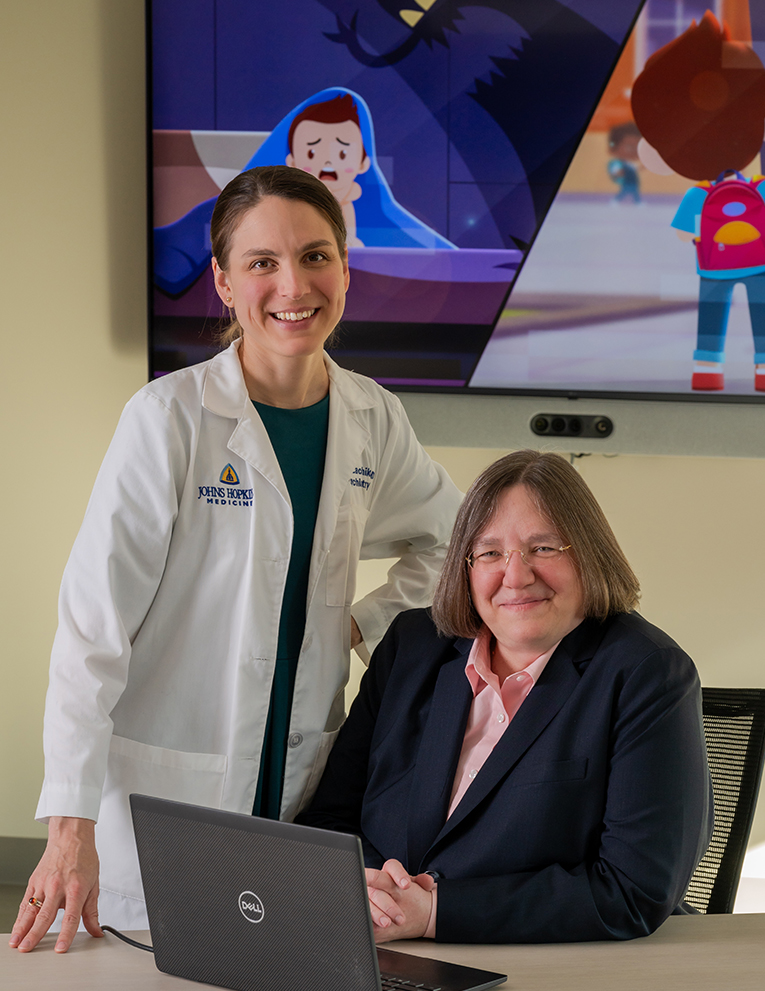Champions for Adolescent Mental Health
A program proven to help high school students will soon reach a new audience: middle schoolers.

Johns Hopkins psychiatrists Claire Zachik and Karen Swartz
The kids are not alright. Rates of clinically elevated depression and anxiety symptoms in adolescents were already on the rise before COVID-19, but a 2021 meta-analysis published in JAMA Pediatrics found that these rates doubled compared to pre-pandemic estimates.
For more than 20 years, the Adolescent Depression Awareness Program (ADAP) has been at the national forefront of evidence-based depression education for high schoolers. Founded in 1999 by a team of Johns Hopkins experts, including psychiatrist Karen Swartz ’91, psychiatric nurse Sallie Mink, and psychiatry and behavioral health sciences faculty member Todd Cox ’95, the program teaches high school students that depression is a treatable medical illness and to tell a trusted adult if they’re worried that they or a friend are experiencing symptoms. Follow-up assessments demonstrate that ADAP’s curriculum outperforms the control, more than doubling the rates of students’ depression literacy compared to preprogram assessments — critically important for increasing the likelihood that they will seek appropriate help when they or their peers need it most.
Over the years, ADAP has scaled its impact by training high school teachers and counselors to deliver the curriculum and by creating virtual education videos. All of this is provided at no cost to the high schools or students. As of October 2023, ADAP had trained 3,449 instructors, reaching more than 137,734 students in 257 schools across the country.
Now, Swartz is partnering with Johns Hopkins child and adolescent psychiatrist Claire Zachik ’15 to expand ADAP’s reach to a new audience: middle schoolers. Dubbed ADAP Junior High, the new program will deploy many of the same tested tactics that have made ADAP so successful in high schools, like training teachers and counselors to deliver the evidence-based curriculum. Key differences will address the unique developmental needs of 10- to 14-year-old students, such as an added focus on anxiety; short and flexible curriculum modules that incorporate an activity; and animated videos to help teach concepts.
“To the extent that ADAP can have a multiplier effect to improve mental health for kids, that is extraordinary.”
Alan Buerger
Philanthropists and advocates, including Alan Buerger and his family, have rallied to support ADAP Junior High. “To the extent that ADAP can have a multiplier effect to improve mental health for kids, that is extraordinary,” says Buerger, who also cites his own family’s experiences with mental illness and ADAP’s model of meeting students where they are as reasons they give.
Doug Strouse, co-chair of the advisory board for the Johns Hopkins Department of Psychiatry and Behavioral Sciences, and his wife, Sharon, support ADAP in memory of their daughter, Kristin Rita Strouse, who was 17 when she ended her own life in 2001. “We got back on our feet because we knew we could help others,” he says.
Advocacy has also come from the three children of Mink, the psychiatric nurse and dear friend of Swartz who helped found ADAP. As adults, Toby Mink, Emmie Frank and Jamie Mink are grateful for the understanding of mental health that their now-late mother instilled in them from a young age. If ADAP and ADAP Junior High can instill a fraction of the awareness of mental health and empathy for those struggling that their mother drilled into them, they say, then there is hope that kids will be able to access the lifesaving care they deserve.
The Adolescent Depression Awareness Program relies on philanthropic support to develop new curriculum like ADAP Junior High and keep the program free for students and teachers. Make a gift to support ADAP Junior High: Read more
